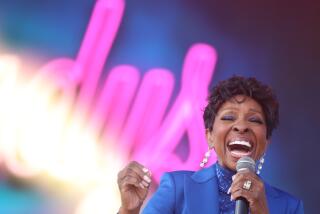Charles’ Pleasing Set a Bit Too Predictable
There’s no denying the ever-popular attractions of Ray Charles. Even when he sings the same old sweet songs we can’t stop loving him.
Still, billing the genre-crossing, blues-meets-gospel artist as a jazz performer may be a stretch. His appearance Wednesday at the Hollywood Bowl’s Jazz at the Bowl series was more about his distinctive pop style than it was about swing, bop or musical improvisation.
And that was just fine with the 14,655 fans who attended. Those who wanted to hear “I Can’t Stop Loving You,” “Georgia on My Mind” and the call-and-response section of “What’d I Say” were not disappointed.
But those hoping to hear Charles explore his jazzier side, as he did on 1961’s “Genius + Soul = Jazz” (and as he’s promised to do on his next recording), were disappointed. His set was as predictable as any he’s done in the last several years.
Despite the predictability of the numbers, Charles infused each with down-home personality, getting cozy inside the lyric with trademark asides, howls and cries of “hey-hey!”and “yeah!” His pacing, as lazy as Grandpa on a hot summer day, added touches of drama, and the enthusiasm he generated was genuine, even though he’s probably performed some of these songs thousands of times.
The promise of what Charles would do in a jazz setting was hinted at during his reading of “Come Rain or Come Shine.” As the 17-piece Ray Charles Orchestra swelled behind him, the singer pulled new mood and nuance from the familiar phrases.
His five-voice backup group, the Raeletts, added sweetness and depth, especially during “I Can’t Stop Loving You.” And the orchestra added a pair of impressive instrumental exercises before Charles was brought to the stage. The only valid complaint, aside from Charles’ voice being too low in the sonic mix during the early going, is that the Genius didn’t bend his show even slightly to fulfill the promise of jazz at the Bowl.
Opening act Gerald Albright played tenor and soprano saxophones on unexceptional backbeat and ballad numbers, following uninspired paths through his solos to punctual, dynamic climaxes. An exception was his soprano play on “Lucky Seven,” which showed more considered, inventive thinking.
More to Read
The biggest entertainment stories
Get our big stories about Hollywood, film, television, music, arts, culture and more right in your inbox as soon as they publish.
You may occasionally receive promotional content from the Los Angeles Times.









